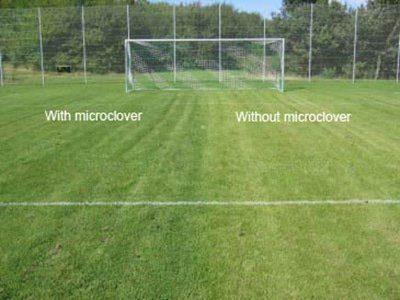
There’s snow on the garden and I’m deep into 2013 seed and plant catalogues. There are so many new plants on my must-grow list for the coming spring, and one that surprised me is ‘Pipolina’ micro clover (Trifolium repens ‘Pipolina’, from oscseeds.com).
Every spring I throw some white clover seed onto the lawn, where it grows well on clay loam soil, in bright sun and semi-shade. Clover thickens the turf, feeds the lawn by fixing gaseous nitrogen into solid form in the soil, and stays green when lawn grasses are temporarily brown during summer droughts. It withstands foot traffic, gets cut along with the lawn grasses, and reduces thatch buildup, which is the result of excessive fertilizer application. Lawns with 10 to 20 per cent clover content can get by with one fertilizer application in fall.
The white clover I’ve been growing is Trifolium repens, sometimes known as Dutch white clover, or ladino clover. Left uncut, it would stand about eight inches (20 cm) tall, and spread out into mats over the soil by prostrate stems that act as rooting runners. Its white flowers are a good nectar source for pollinators, although regular mowing prevents flowers from forming.
Hybrid ‘Pipolina’ white clover is shorter, reaching only four to six inches (10 to 15 cm) tall, has smaller foliage and seldom flowers. This miniature clover has all the usual advantages as a companion to turf grass, but less visual presence. For fastidious gardeners wanting to see a consistent greensward, the small leaves of ‘Pipolina’ are less visible mixed among the lawn grasses. But I can think of other uses for this micro clover, particularly as a surface for garden paths, in shrub borders, or even as a lawn substitute where mowing is infrequent. The low flower production would keep the clover turf from becoming a Mecca for honeybees (apologies to all pollinators), consequently there would be no fear of bee stings. If used as a groundcover for paths (perhaps in a vegetable patch), thorough edging once every growing season would eliminate any colonies that spread beyond their intended space (although you might be glad to keep them). As flowering is infrequent, there would be little spread from seeds.
One unexpected advantage to clover in the lawn has been its effect on rabbit diets. My family enjoys watching rabbits in the garden, and fortunately the bunnies ignore ornamental perennials in favour of the clover. Since strong colonies of clover have been established in the lawn, our resident rabbits dine exclusively on clover leaves. They never destroy the crowns of the plants, thereby ensuring foliage regeneration and more delicious meals. (Previous to the clover presence, the favoured rabbit meal was perennial geraniums.) Considering all the benefits of using ‘Pipolina’ clover as a companion plant to turfgrass, that’s a lot of value coming from a miniature plant.









Can i spread pipolina microclover seed directly on my lawn ?
Interesting article. Thanks Colleen. Have you tried exclusively only micro clover?
Its what I am now doing, now that pipolina is way more available and affordable 7 years down the road
We plan to introduce this seed to our landscaping clients in Nova Scotia. How well does this seed hold its germ if we don’t use it all this season? Grass seeds lose germination power…does clover too?
Hi Judith!
I can’t seem to find any information on whether clover would do all right on its own, not combined with grasses. The reason I’m considering it in the first place is I’m assuming a weed would be less thirsty than grass, and the idea of combining it with grass seems to defeat my purposes. Any thoughts?
Hi Marie,
Yes, you can use clover to make a lawn (without turf grasses). The clover seed germinates best in cool wet weather, best in spring, but also possible in fall. The seed can be broadcast by hand and doesn’t need to be covered or mulched. It will germinate in about two to three weeks, and you’ll get reasonable coverage the first season, and thick coverage in the second season. A clover lawn can be walked on. If you leave it uncut, expect lots of clover flowers and hovering bees; but a weekly mowing will prevent flowering if you don’t want to attract bees. Rabbits love to eat clover, and in my garden, they prefer it over any kind of ornamental plant. If you’re going to purchase a large amount of clover seed for making a lawn or use it to drought-proof a thin turf grass lawn, look for Dutch white clover (Trifolium repens), sold in garden centres in spring, or anytime online (oscseeds.com). Using a hybrid cultivar like ‘Pipolina’ for making an entire lawn would be quite expensive.
– Judith
Well I did it, I laid down my first 125 grams of MicroClover Trifoliumn Repens Pipolina seeds this weekend! I will post my before and after pictures once I see some progress. May the 4 leaf clovers be with me!
Cheers,
Steph
Hi Steph… any updates on your lawn? Did you buy seed from OSC?
How did you make out with the clover as a lawn substitute?
Thanks,
Robert F
I got a newsletter from Nichols Garden Nursery in OR (USA) today that mentioned the pipolina clover, but thought the price was too high. However, it seems to be less that the one listed @ OCSC Seeds. However, I didn’t check the shipping price. Web searches don’t turn up any other results that I’ve been able to find, at least for home gardeners.
https://www.nicholsgardennursery.com/store/product-info.php?pid1169.html
Appreciate the blog topic though, and thought the idea of planting between beds interesting. I’ve got bermuda everywhere, so have tried several tactics for between beds; cardboard/magazines under pavers works best, but would be less $ for clover.
It might be good to add where it can be found and the relative price.
http://www.oscseeds.com/detail/index.php?Proid=6737
There didn’t seem to be a lot of places listing it. Fairly pricey if a large area is needing attention
Sow at 25 g per 52 m2 (560 ft2).
Size: 25 g Price: $6.95
Size: 125 g Price: $19.95
Hi Sharon: The post about ‘Pipolina’ micro clover did include a source for the seed. Thanks for the information on coverage and pricing.